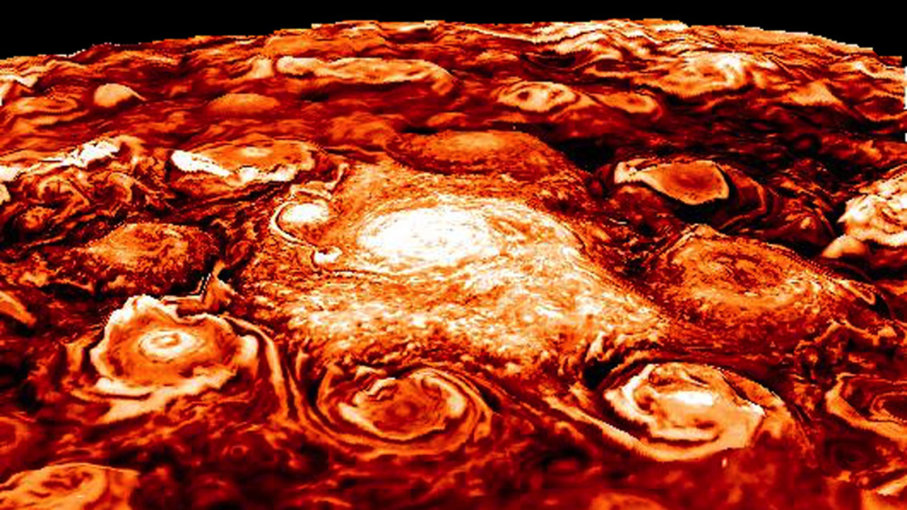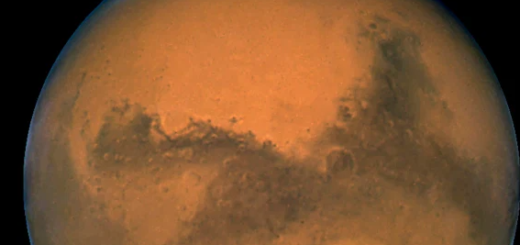Mega-hurricanes and Monstrous Jets Lie Beneath Jupiter’s Clouds

You’re looking at a computer-enhanced image of the cyclones that Juno observed and captured above Jupiter’s north pole. You can spot the central cyclone, which is surrounded by eight more storms, each of which is thousands of miles across. NASA/JPL-CALTECH/SWRI/ASI/INAF/JIRAM
NASA’s Juno mission to Jupiter is just a third of the way through its daring adventure, and it has already revolutionized our knowledge of the gas giant.
The latest findings, published in a series of papers in the journal Nature, dive deep below Jupiter’s famous atmospheric swirls and stripes and reveal an environment that’s completely alien to anything our planet has to offer.
Using data gathered from Juno’s sophisticated suite of instruments, researchers have found that Jupiter’s storms aren’t confined to the uppermost layers of the Jovian atmosphere. They penetrate deep and last much longer than Earth’s atmospheric processes. Like a compact series of cogs in an unimaginably large machine, vast cyclones also swirl around the north and south poles, clocking wind speeds of over 220 miles per hour (350 kilometers per hour) – wind speeds that are the equivalent of a terrestrial Category 5 hurricane.
“These astonishing science results are yet another example of Jupiter’s curve balls, and a testimony to the value of exploring the unknown from a new perspective with next-generation instruments,” said Scott Bolton, Juno’s principal investigator at the Southwest Research Institute, San Antonio, in a statement from NASA’s Jet Propulsion Laboratory.
Of all the images released by Juno to date, the computer-reconstructed infrared views of Jupiter’s atmosphere, like the one pictured above, are particularly awe-inspiring. Juno’s Jovian Infrared Auroral Mapper (JIRAM) instrument can measure the planet’s heat percolating through the atmosphere, probing the weather systems up to 45 miles (72 kilometers) below, day or night.
“Prior to Juno we did not know what the weather was like near Jupiter’s poles. Now, we have been able to observe the polar weather up-close every two months,” said Alberto Adriani, Juno’s co-investigator from the Institute for Space Astrophysics and Planetology, Rome, in the same statement. “Each one of the northern cyclones is almost as wide as the distance between Naples, Italy and New York City – and the southern ones are even larger than that. They have very violent winds, reaching, in some cases, speeds as great as 220 mph (350 kph). Finally, and perhaps most remarkably, they are very close together and enduring. There is nothing else like it that we know of in the solar system.”
Here’s another finding, courtesy of Juno: Unlike Saturn’s enigmatic hexagonal (six-sided polygon) cloud structure over the ringed gas giant’s north pole, Jupiter’s northern cyclones form an octagonal (eight-sided) grouping. In addition, over the planet’s south pole, a pentagonal (five-sided) grouping of storms persists. Astronomers aren’t sure about the science behind these shapes, how they interact and why there’s a difference between the atmospheres of Jupiter and Saturn.
And there’s more. Another study using data from Juno’s gravity measurements reveals that Jupiter’s counterrotating stripes are a two-dimensional representation of a vast three-dimensional jet stream structure deep inside the planet, and these jets are deeply embedded within the planet’s powerful gravitational field.
Jupiter’s southern hemisphere
Juno captured this picture of Jupiter’s colorful southern hemisphere on a flyby performed on Dec. 16, 2017.
NASA/JPL-CALTECH/SWRI/MSSS/KEVIN M. GILL
“Galileo viewed the stripes on Jupiter more than 400 years ago,” said Yohai Kaspi, Juno’s co-investigator from the Weizmann Institute of Science, Rehovot, Israel. “Until now, we only had a superficial understanding of them and have been able to relate these stripes to cloud features along Jupiter’s jets. Now, following the Juno gravity measurements, we know how deep the jets extend and what their structure is beneath the visible clouds. It’s like going from a 2-D picture to a 3-D version in high definition.”
With these discoveries came the realization that Jupiter’s weather systems extend far deeper than thought possible. These weather systems churn down to a depth of 1,900 miles (3,000 kilometers), and this layer contains a huge amount of stuff — accounting for approximately 1 percent of the mass of the entire planet. As a comparison, our atmosphere accounts for less than one-millionth of Earth’s mass.
Juno is only the second spacecraft to orbit Jupiter, the first was NASA’s Galileo mission that orbited the gas giant from 1995 to 2003. Juno arrived at Jupiter in 2016 and can stare deeper than Galileo, revealing new mysteries that will undoubtedly keep scientists busy for years to come.



 Creators of mankind
Creators of mankind Description of “Tall white aliens”
Description of “Tall white aliens” Where they came from?
Where they came from? About hostile civilizations
About hostile civilizations The war for the Earth
The war for the Earth “Tall white aliens” about eternal life
“Tall white aliens” about eternal life Video: “Nordic aliens”
Video: “Nordic aliens” Aliens
Aliens Alien encounters
Alien encounters The aliens base
The aliens base UFO
UFO Technology UFO
Technology UFO Underground civilization
Underground civilization Ancient alien artifacts
Ancient alien artifacts Military and UFO
Military and UFO Mysteries and hypotheses
Mysteries and hypotheses Scientific facts
Scientific facts


















